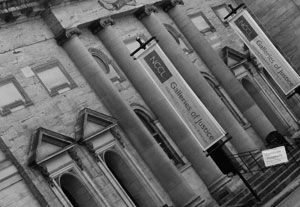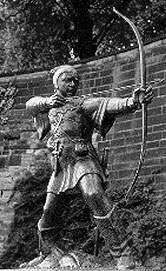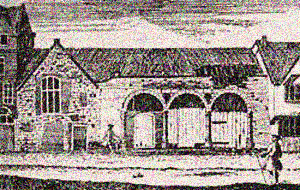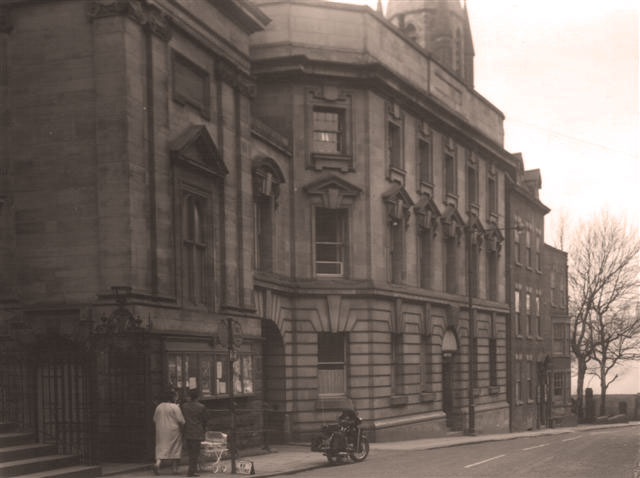.: History of the Galleries of Justice
 The Galleries of Justice is a museum of Crime and Punishment and is housed in the old Nottingham Shire Hall. The Galleries stands on a site dating back to 600AD and is the base for Nottingham's original Saxon settlement. In those days Nottingham was known as Snotta inga ham, which means village belonging to Snotta. It is not know whether the site of the Galleries was used for justice and imprisonment in the dark ages due to the lack of written records. However archaeologists have uncovered some major clues in the sandstone caves which suggests that the site was linked with punishment and imprisonment from Saxon times onwards.
The Galleries of Justice is a museum of Crime and Punishment and is housed in the old Nottingham Shire Hall. The Galleries stands on a site dating back to 600AD and is the base for Nottingham's original Saxon settlement. In those days Nottingham was known as Snotta inga ham, which means village belonging to Snotta. It is not know whether the site of the Galleries was used for justice and imprisonment in the dark ages due to the lack of written records. However archaeologists have uncovered some major clues in the sandstone caves which suggests that the site was linked with punishment and imprisonment from Saxon times onwards.
 When the Normans invaded and appointed Sheriffs as keepers of the peace and the collectors of taxes, the county Sheriff's were based on this site dating back to 1125. However there is currently no evidence that they were based here from the beginning, but it is known that the site was referred to as the Sheriffs Hall. County Hall or the Kings Hall. Was this the base of Robin Hood's arch enemy the Sheriff of Nottingham?
When the Normans invaded and appointed Sheriffs as keepers of the peace and the collectors of taxes, the county Sheriff's were based on this site dating back to 1125. However there is currently no evidence that they were based here from the beginning, but it is known that the site was referred to as the Sheriffs Hall. County Hall or the Kings Hall. Was this the base of Robin Hood's arch enemy the Sheriff of Nottingham?
The first written records show that the site was used as a court is in 1375,however, this is not to say that it was not used for courts before this date.
The first written record which shows the site being used for a prison is from 1449, but again it is possible it could have been used for this purpose for as long as there had been a court here. As you can see there is a pattern emerging across the centuries that the site of the Galleries was used in some way to enforce law and order for the county.
 From the 17th Century there is a reasonable amount of documentation relating to the building and the need for it to be rebuilt. There were many discussions which continued for decades, with no action being taken. Then in 1724 one of the courtroom floors collapsed while the shocked judge watch as the solicitors, jury, public and the accused all went crashing into the cellars. The Nottingham Courant in March 1724 recorded:
From the 17th Century there is a reasonable amount of documentation relating to the building and the need for it to be rebuilt. There were many discussions which continued for decades, with no action being taken. Then in 1724 one of the courtroom floors collapsed while the shocked judge watch as the solicitors, jury, public and the accused all went crashing into the cellars. The Nottingham Courant in March 1724 recorded:
'On Monday morning, after the Judge had gone into the County Hall, and a great crowd of people being there, a tracing or two that supported the floor broke and fell in and several people fell in with it, about three yards into the cellar underneath. Some were bruised, but one man named Fellingham was pretty much hurt, one leg being stripped to the bone, and was much hurt. This caused great consternation in Court, some apprehending the Hall might fall, others crying out "Fire"! etc. which made several people climb out of the windows. The Judge, being also terribly frightened, cried out "A plot! A plot!", but the consternation soon being over the Court proceeded to business.'
The Hall was re-built between 1769 - 1772. The architect was James Gandon from London and cost about £2,500 (£296,887 as of 2010). The builder was James Pickford of Derby. The inscription on the top of the building reads: This County Hall was erected in the year MDCCLXX and in the tenth year of the reign of His Majesty George III. The building was fronted by an iron palisade to help control unruly crowds on the occasion of a public hanging.
 In the 19th Century additional wings were added, somewhere between 1820 and 1840. The judges retiring room, barristers robing room and the office for a clerk were added in 1844. A new grand jury room was added in 1859 and in 1876 major improvements were made, but within weeks a fire broke out and nearly destroyed the completed work. The courts were largely rebuilt between 1876 and 1879, the Victorians also closed the jail in 1878 due to appalling conditions and it lay empty until 1995. However the courts remained in use until 1991 when the new Nottingham Crown Court was constructed in Nottingham.
In the 19th Century additional wings were added, somewhere between 1820 and 1840. The judges retiring room, barristers robing room and the office for a clerk were added in 1844. A new grand jury room was added in 1859 and in 1876 major improvements were made, but within weeks a fire broke out and nearly destroyed the completed work. The courts were largely rebuilt between 1876 and 1879, the Victorians also closed the jail in 1878 due to appalling conditions and it lay empty until 1995. However the courts remained in use until 1991 when the new Nottingham Crown Court was constructed in Nottingham.
County Police Station
High Pavement Police Station was headquarters for the Nottinghamshire County Police from 1847 to 1954. The present station was built in 1905 and housed the Chief Constable, Force Administration, CID and recruits.
“The Chief Constable’s report of 1922 said they had only been able to build on a small piece of ground and they had “always been very much cramped for room.” They had only been able to manage because the superintendent of the Nottingham Division was also the Deputy Chief Constable and lived in the Judge’s lodgings. The present position, reported the Chief, was that the whole of the admin work of HQ was contained in five rooms, one of which was a telephone room, and the accommodation was only just adequate. Work for the Nottingham Petty Sessional Division, which had a population of 130,000 circling the Nottingham area, was the equivalent of a borough like Huddersfield and had to be done in two rooms. The superintendent living on the premises then had accommodation “less adequate than any in England.” “His wife not only has to act as police matron but also has to cook for the single men necessarily resident on the premises,” the Chief’s report disclosed. “This is a state of things which does not make for the maintenance of discipline. Having most carefully kept from embarrassing the county authorities in their efforts to secure accommodation for their officials, I recognize the extreme difficulty on their position, but it has now seriously reached a point where if the premises are further curtailed we cannot do the work efficiently. No other County force in England with a similar strength is doing the work on anything like the same amount of ground,” he reported to Viscount Galway.”(2)
In 1954 the County Force headquarters moved to larger premises at Epperstone Manor, and was officially opened by Sir David Maxwell-Fyfe, Secretary of State for the Home Department. High Pavement police station then became a divisional headquarters and closed in 1985. However, the cells continued to be used as a court holding facility for a further 2 years. There was a separate cell for women prisoners, which contained a ‘private’ toilet and double bed.